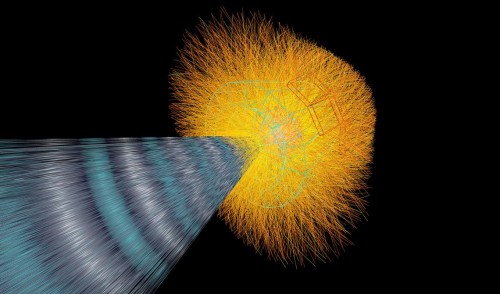
Simulation of a lead-ion collision in the ALICE detector. (Courtesy: CERN)
By James Dacey
As concept albums go, the latest release by Jake Hertzog can certainly be stacked at the intellectual end of your record collection. This week, the US jazz-rock guitarist released his sixth studio album, entitled Well Lit Shadow – a suite of solo electric-guitar tracks inspired by images from the Large Hadron Collider (LHC) and other experiments at the CERN particle-physics lab. You can find details of how to purchase or stream the album on Hertzog’s website.
Now, I’m not the world’s biggest jazz aficionado but I gave the album a listen and it’s far more accessible than the concept might suggest. Hertzog’s musicianship shines through and bright walking riffs on tracks such as “Star Drops” and “Traces of You” evoke images of devoted researchers working through vast amounts of data in pursuit of knowledge. According to Hertzog’s website, some of the pieces are very literal attempts to depict the chaos and beauty of subatomic-particle collisions, while other tracks are more abstract meditations on the deeper meaning of these experiments. The album’s title track is described as “a musical poem dedicated to the philosophical implications of this science”.
This is not the first time that Hertzog has been inspired by science. His first three albums were called Chromatosphere (2009), Patterns (2010) and Evolution (2011), while last year his band released a collection of jazz classics called Beyond the Standard Model. Hetzog’s fascination with physics is no doubt influenced by his father David Hertzog, a neutrino researcher involved in several projects including the proposed Muon g–2 experiment designed to test the Standard Model through sensitive measurements of muons subjected to string magnetic fields.
Well Lit Shadow will join a growing body of music inspired by particle physics. In 2011 we produced a short film about classical composer Edward Cowie’s series of works for violin that traced the history of particle physics from the late 19th century through to the present day. There is the CERN physicist and guitarist Piotr Traczyk, who has created heavy metal music inspired by data from the CMS experiment. Then, of course, there was the “Large Hadron Rap”, which has so far attracted nearly eight million views on YouTube. Particle physicists working on the ATLAS experiment at CERN released an album in 2010 and more recently a pair of Mexican physicists have created a “cosmic piano”.
To find out more about the overlapping worlds of music and science check out our recent podcast “Rocking the status quo in science“.
Guidelines
Show/hide formatting guidelines
this text was deletedwhere people live in harmony with nature and animals</q>
Some text